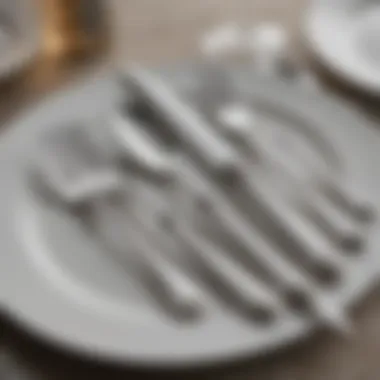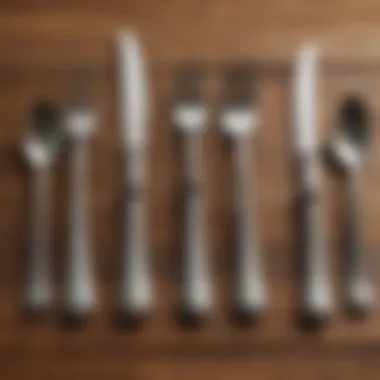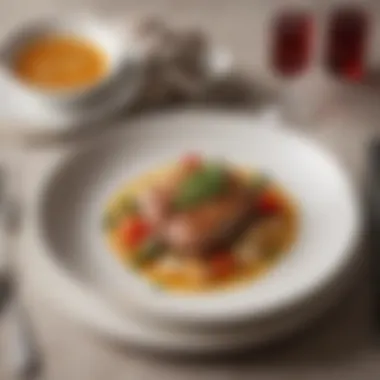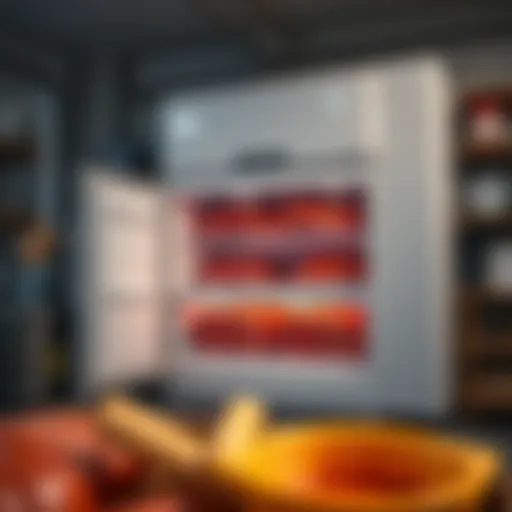Dinner Flatware: A Comprehensive Guide


Intro
Dinner flatware is more than mere utensils; it is a key element that shapes our dining experiences. Understanding the significance of flatware can elevate both the aesthetic appeal of a meal and the joy of sharing it with others. This article explores various aspects of dinner flatware, from its historical context to material choices, as well as care instructions. Additionally, it delves into the aesthetic influence of designs, particularly floral patterns, on dining environments.
The consistent evolution of dinnerware has reflected cultural shifts and advances in craftsmanship. Exploring these dynamics is essential to grasp how chosen flatware can enhance a meal's presentation and enjoyment.
A well-thought-out selection of flatware not only serves practical purposes but can also resonate with personal style and preferences, making each dining occasion unique.
Historical Overview of Dinner Flatware
Historically, flatware has transitioned from basic tools for eating to elaborate sets symbolizing status and event formality. In ancient civilizations, materials such as wood, bone, and later metals like bronze were utilized. By the Middle Ages, elaborate forms of flatware began to emerge, highlighting the craftsmanship of the period.
With the Industrial Revolution came mass production, which broadened access to quality flatware. Today, a plethora of materials and designs are available, catering to diverse tastes and preferences.
Types of Dinner Flatware
Understanding the different types of dinner flatware is crucial for informed selection. Here are the most common categories:
- Cutlery: Includes knives, forks, and spoons. Each piece has specific uses, like the dinner fork for main courses and dessert fork for sweets.
- Serving Utensils: Larger versions of standard cutlery that facilitate the serving of dishes, such as ladles and serving spoons.
- Specialty Utensils: This category contains items like fish forks and cheese knives that cater to specific culinary needs.
Materials Used in Flatware
Choosing the right material for flatware involves consideration of durability, maintenance, and aesthetics. Common materials include:
- Stainless Steel: Widely favored for its resilience and resistance to rust and corrosion.
- Silver: Traditional and elegant, though more prone to tarnishing and needing regular polishing.
- Plastic: An economical, disposable option suitable for casual dining but lacks durability.
Care and Maintenance of Flatware
Proper care extends the life of dinner flatware and maintains its appearance. Here are essential tips:
- Wash by Hand: For stainless steel and silverware, hand washing is often recommended to prevent scratches from dishwashers.
- Use Non-Abrasive Cleaners: Avoid harsh chemicals; instead, opt for mild soap and warm water.
- Dry Thoroughly: To prevent water stains, ensure each piece is dried completely before storage.
"A well-maintained set of dinner flatware can last for decades, adding a touch of elegance to every meal."
The Influence of Floral Design on Dining Aesthetics
Floral patterns on flatware can significantly influence the ambience of a meal. These designs add vibrancy and warmth, creating an inviting atmosphere. Selection of subtler floral motifs can evoke a sense of tranquility, while bold, colorful patterns can inject energy into the dining experience. A thoughtful pairing of flatware design with tableware and decor enhances not only the meal but also the overall experience.
Ending
In summary, dinner flatware serves many more purposes than aiding in eating. It is intertwined with history and craftsmanship, reflects personal style, and influences the dining atmosphere. Selecting the right flatware type, material, and design contributes significantly to enhancing the overall dining experience, turning any meal into an occasion.
Prelims to Dinner Flatware
In the realm of culinary arts, dinner flatware holds a crucial place. It influences not only the presentation of a meal but also the entire dining experience. Choosing the right flatware can enhance the aesthetics of a table setting, which plays a significant role when hosting gatherings or family meals. This guide aims to explore the essential aspects of dinner flatware, its cultural significance, and practical guidance for selection and maintenance.
Understanding Dinner Flatware
Dinner flatware comprises various utensils used during meals, including forks, knives, and spoons. Each piece has its specific purpose, influenced by the course of a meal served. For example, a standard place setting may include a dinner fork, a knife, and a soup spoon. The design and feel of flatware can significantly impact not only the look of the dining table but also the comfort of dining. Comfort is an often overlooked factor; heavy or awkward flatware can make eating more laborious, while finely crafted pieces can enhance enjoyment.
Cultural Significance
Flatware is more than just tools for eating; it represents cultural identity and traditions. Across the globe, different cultures have developed unique styles of flatware. For example, Japanese culture emphasizes the use of chopsticks, while Western cultures predominantly use forks and knives. The materials used also reflect cultural values. Silver and gold utensils are connected with affluence in some societies, while others may favor wooden or bamboo options due to ecological concerns.
"Cultural contexts shape how we view and utilize flatware, making it an important study subject in understanding global dining practices."
In summary, understanding dinner flatware is essential for food lovers. It allows them to appreciate the nuances of different cultures and experiences and enhances their culinary adventures.
Historical Overview of Flatware
Understanding the historical evolution of flatware provides valuable insights into not only dining practices but also cultural norms and technological advancements. The development of flatware reflects societal changes and culinary habits. An intricate relationship exists between dining tools and cultural identity. Thus, examining the journey of flatware enriches the reader's appreciation for everyday dining experiences. This exploration reveals the artistry, craftsmanship, and functional considerations inherent in flatware designs through time.
Origins of Flatware
The roots of flatware can be traced back to ancient civilizations. Initially, humans utilized simple tools for eating. The earliest utensils were most likely made of wood, bone, or stone. These rudimentary forms catered to basic needs. As societies progressed, so did the fabrication of more specialized flatware. By the time of the Egyptians, forks were used for cooking but not yet for eating.
Later, the Romans advanced flatware design significantly. They introduced spoons made from metal and other materials. Spoons had ornate designs, often featuring intricate decorations. Additionally, the use of knives became more prevalent. Interestingly, it took centuries for forks to gain acceptance in Europe; they were first used in Italy in the 10th century. Their slow integration reflected social attitudes toward dining.


Evolution Through the Ages
From the Middle Ages through the Renaissance, flatware experienced notable transformations. During this period, elaborate designs emerged as visible status indicators. The wealthier classes often showcased their status with expensive materials and custom designs. The introduction of silver and gold utensils exemplified the wealth of a household. This trend continued into the 18th and 19th centuries, with ornate styles dominating many Westerm dining tables.
The Industrial Revolution significantly changed the production of flatware. Mass production techniques allowed for affordability and accessibility. As a result, more people could participate in dignified dining experiences. Stainless steel gained popularity due to its durability and resistance to tarnishing. This advancement marked a shift towards practicality without compromising aesthetics.
In contemporary settings, flatware has undergone ongoing evolution. The mingling of traditional craftsmanship with modern design techniques leads to a diverse array of flatware styles. Minimalist designs contrast with more elaborate styles, catering to varied preferences. Today, dining experiences are seen as opportunities to showcase personal style, making the choice of flatware an important element of meal presentation.
Flatware Trends in Different Cultures
Flatware is not just a practical necessity; it also illustrates the unique rhythm of cultural practices. For instance, in Asian cultures, chopsticks serve as the primary eating utensils. They reflect deeply ingrained traditions and dining etiquette. In contrast, Western cultures have placed emphasis on the use of forks and knives, creating distinct dining rituals.
Moreover, contemporary dining increasingly embraces fusion styles. Intercultural influences encourage creativity in flatware design and usage. This blend enriches dining practices while creating unique experiences. Knowing about these cultural variations allows individuals to appreciate the richness of global culinary traditions.
The transformation of flatware through history serves not just functionality but also as a mirror reflecting cultural identity.
Understanding the dynamics within flatware's evolution enables deeper appreciation for the tools we use every day. This knowledge enhances our interactions with food, elevating both the culinary experience and the overall dining atmosphere.
Types of Dinner Flatware
Understanding the various types of dinner flatware is essential for creating a well-appointed dining experience. Each type serves a specific purpose, contributing to the overall enjoyment of meals and enhancing the aesthetics of the dining table. Proper selection can reflect personal style and adhere to cultural norms. This section examines key categories of flatware, outlining their significance and appropriate applications.
Basic Flatware Settings
A basic flatware setting refers to the standard arrangement of utensils used for most meals. Typically, it includes a dinner fork, knife, and spoon. Understanding these utensils is necessary for both etiquette and functionality. The dinner fork is used to pick up solid food while the knife assists in cutting. The spoon, meanwhile, is ideal for soups or desserts.
When laying a table, the fork generally sits to the left of the plate, the knife to the right with the blade facing inward, and the spoon follows the knife. This arrangement facilitates ease of use during a meal, allowing diners to grasp utensils with minimal fuss.
Benefits of Basic Settings:
- Simplicity: Easy to learn and use.
- Efficiency: Supports a wide variety of dishes.
- Versatility: Suitable for most dining occasions.
Specialty Utensils
Specialty utensils elevate the dining experience by providing tools tailored to specific foods or styles of service. These include items such as salad forks, dessert spoons, and fish knives. Each serves a distinct function and enhances the enjoyment of particular dishes.
For example, a salad fork is typically smaller than a dinner fork, making it more suitable for leafy greens. The fish knife, with a rounded and flexible blade, allows for efficient handling of fish dishes.
"Understanding specialty flatware is crucial for anyone who appreciates fine dining as it demonstrates consideration for taste and service."
Including a selection of specialty utensils can make a table feel more complete. While they may not be necessary for everyday meals, they certainly add a touch of elegance to special occasions.
Flatware for Everyday vs. Formal Use
Flatware usage varies significantly between everyday dining and formal occasions. Each context demands different considerations in terms of design, material, and arrangement.
Everyday Flatware:
- Durability: Materials like stainless steel are common, offering resistance to wear and easy maintenance.
- Practicality: Often, this cutlery is lightweight and dishwasher safe, making it suitable for daily use.
- Informal Design: Many everyday sets feature simple designs that emphasize function.
Formal Flatware:
- Elegance: Formal dining requires more ornate designs, often made from higher quality materials like sterling silver.
- Completeness: Sets might include a wider range of utensils to cater to multiple courses, including soup spoons and dessert forks.
- Careful Arrangement: Formal settings adhere to specific placement rules, which enhances the experience for guests.
Materials Used in Flatware
Understanding the materials used in flatware is essential for several reasons. First, it impacts the durability and overall quality of the utensils. Second, it influences the aesthetic appeal and style of the dining experience. Different materials possess unique characteristics that can enhance or detract from the enjoyment of meals. Ultimately, choosing the right material depends on personal preferences, usage scenarios, and maintenance requirements.
Stainless Steel
Stainless steel is one of the most popular materials for making dinner flatware. Its strength and resistance to rust and corrosion make it a practical choice for everyday use. Stainless steel can endure significant wear and tear, allowing it to maintain its appearance even after repeated washing.
There are various grades of stainless steel, with 18/10 being the most common for quality flatware. This means the alloy contains 18% chromium and 10% nickel, which enhances its luster and resistance to tarnishing. Stainless steel is also relatively easy to clean, making it suitable for busy households or dining establishments.
Silver Plated and Sterling Silver
Silver plated and sterling silver flatware offers a touch of elegance and sophistication. Sterling silver, comprised of 92.5% pure silver, has a timeless appeal. It tends to become a family heirloom, passed down through generations. With proper care, these utensils can retain their stunning luster for many years.


However, silver requires more attention than stainless steel. It can tarnish if not stored properly or cleaned regularly. Investing in silver flatware also comes with a higher price tag compared to stainless steel options. Many people appreciate the aesthetics and tradition of using silver plated or sterling utensils, especially for special occasions or formal gatherings.
Plastic and Composite Materials
Plastic and composite materials have gained popularity in recent years, especially in casual dining and outdoor settings. This material is lightweight, break-resistant, and available in a wide array of colors and designs. Furthermore, plastic flatware is often disposable, catering to convenience during parties or picnics.
While plastic may not provide the same level of strength or prestige as metal flatware, improvements in design have made modern plastic options increasingly appealing. Many manufacturers now create stylish and functional plastic utensils that can enhance the dining experience without extensive upkeep. However, they may not be the best option for formal settings or when durability is a priority.
Eco-Friendly Alternatives
With growing environmental awareness, the demand for eco-friendly flatware has increased. Materials like bamboo, recycled metals, and biodegradable composites present greener options for dinnerware. Bamboo, in particular, is a renewable resource, making it a popular choice among consumers who prioritize sustainable materials.
Using eco-friendly flatware not only minimizes waste but also aligns with a lifestyle choice focused on sustainability. While some eco-friendly options may differ in durability compared to traditional materials, evolving production methods continuously improve their performance and usability.
Choosing the Right Dinner Flatware
Selecting the appropriate dinner flatware is essential for elevating the dining experience. Flatware is not just a tool for eating; it plays a significant role in the presentation of food and the overall ambiance of the meal. Choosing the right pieces requires a thoughtful approach, considering various elements that can impact both functionality and aesthetic appeal.
Factors to Consider
When deciding on dinner flatware, several factors should influence your choice:
- Material: The material of the flatware can affect durability, maintenance, and appearance. Stainless steel is popular for its strength and low upkeep, while silver offers elegance but requires more care.
- Weight and Balance: The weight of the flatware can influence comfort during use. Heavier utensils may feel more substantial and luxurious, whereas lighter options can be easier to handle.
- Design and Style: Consider the design that complements your table settings and dining style. Sleek, modern designs may suit a contemporary setting, while ornate pieces might be better for formal occasions.
- Functionality: Think about how frequently you will use the flatware. Everyday utensils can differ from those meant for special occasions.
Building a Flatware Collection
Constructing a flatware collection can be an enjoyable venture. It is beneficial to start with some basic pieces and gradually expand your collection as your needs elevate. Here are some tips:
- Begin with a basic set that includes dinner forks, knives, and spoons, which you can use for everyday meals.
- Consider acquiring specialty utensils later, like fish forks or dessert spoons, as you identify your dining preferences.
- Pay attention to versatility in your collection. Items that are functional for both casual and formal settings are practical.
- Invest in quality over quantity. It is better to have fewer high-quality pieces than many lower-quality items.
Matching Flatware to Table Settings
Successfully matching flatware to table settings requires attention to detail. The right flatware can enhance the overall presentation of the table.
- Ensure that the style of the flatware fits the theme of your table arrangement. Traditional, modern, or rustic designs should harmonize with each other.
- The finish of the flatware also matters. Polished shiny finishes may suit elegant gatherings, while matte or brushed finishes can provide a more understated vibe.
- Consider the color palette of your plates, table linens, and other decorative elements. Choosing flatware that either contrasts or complements these elements can enhance the aesthetic effect.
"The right dinner flatware can not just serve as a tool, but also a means to transform an ordinary meal into an elegant experience."
Matching flatware to your settings involves not only visual appeal but also ensuring the pieces function well together during the meal.
Ultimately, choosing the right dinner flatware includes careful consideration of material, design, and how it aligns with your dining habits and aesthetic preferences. A deliberate approach will lead to enriched dining experiences.
Care and Maintenance of Flatware
Proper care and maintenance of flatware is crucial in ensuring its longevity and performance. The right techniques can enhance the aesthetic appeal and functional lifespan of your flatware collection. Consideration should be given to the materials used, as different types require distinct cleaning methods and storage solutions. Understanding these factors can prevent damage and maintain the elegance of your dining experiences.
Cleaning Techniques
Cleaning flatware involves more than just tossing it into the dishwasher. While some flatware is dishwasher safe, others require more delicate handling. Here are key points to consider:
- Immediate Rinse: Always rinse utensils shortly after use. This helps to remove food particles and prevents stains, especially on stainless steel and silver flatware.
- Hand Washing: For items that are not dishwasher safe, such as sterling silver, use warm water with mild detergent. A soft sponge or cloth is preferred to avoid scratches.
- Avoid Abrasives: Do not use harsh sponges or abrasive cleaners. These can damage the finish on your flatware. Instead, opt for soft cloths or specially designed cleaning tools.
- Drying: After washing, ensure the flatware is dried thoroughly with a soft towel. Leaving it to air-dry can lead to water spots, particularly on stainless steel. Next time, notice how such details affect your table settings.
"Proper care of your flatware not only keeps it looking new but also preserves its functionality for years to come."
Storage Solutions
How flatware is stored plays a significant role in its maintenance. Effective storage not only keeps the pieces organized but also protects them from scratches and tarnishing. Here are some methods:
- Drawer Organizers: Use drawer dividers to keep your flatware separated. This prevents scratching and allows for easy access during meals.
- Flatware Caddies: For those who prefer to display their flatware, caddies can be a good option. Just ensure they offer some protection from environmental factors.
- Wool or Cotton Pouches: For silver or specialty pieces, consider using cloth pouches. This will shield them from tarnishing due to air exposure.
- Humidity Control: Store your flatware in a low-humidity environment to reduce tarnish. Silica gel packets can be helpful in controlling moisture levels.
Regular attention to cleaning and meticulous storage will enhance not just the visual appeal of your flatware but also the overall dining experience.
The Role of Design in Flatware
Design plays a pivotal role in flatware, influencing both the dining experience and the aesthetic value of the table setting. The craftsmanship and visual appeal directly impact how a meal is perceived. When selecting flatware, one must consider elements such as the shape, finish, and style. These factors contribute not only to the elegance of a table but also to the comfort of use. A well-designed piece of flatware enhances enjoyment, making the act of dining more pleasurable and memorable.
Aesthetic Considerations


Aesthetic considerations in flatware design encompass various factors that affect the overall perception of a meal. The material choice, color schemes, and styles all play crucial roles.
- Material: Flatware can be crafted from a variety of materials, including stainless steel and silver. Each material provides a distinct visual effect. A polished silver set may convey sophistication, while matte finishes can suggest a modern approach.
- Color and Finish: The finish of flatware influences its elegance. For instance, a shiny surface reflects light and captures attention, while a brushed finish can give a more understated, contemporary feel.
- Style: Flatware comes in various styles, from modern minimalism to traditional ornate designs. The choice of style should align with the theme of the meal or occasion, enhancing the overall dining experience.
"The right flatware transforms not just the meal. It changes the entire atmosphere of dining."
Incorporating unique design elements such as intricate handles or unique shapes can elevate a simple meal into a more refined experience. These details are not just superficial; they invite diners to engage more fully with the act of eating.
Ergonomics and Functionality
The ergonomic design of flatware concerns how comfortably and efficiently utensils can be used during dining. It is vital that flatware is designed to suit the hand's natural motion. This aspect of design can often be overlooked but is significant in ensuring a smooth and enjoyable dining experience.
- Grip: Flatware should feel comfortable in the hand at the moment of dining. A well-contoured handle facilitates easier maneuvering, especially for intricate tasks like cutting.
- Weight and Balance: A proper weight ensures that utensils are easy to handle without feeling cumbersome. Flatware that is too heavy can tire the hand, affecting the dining experience negatively.
- Usability: Each utensil must serve its purpose efficiently. For instance, a fork must effectively spear food, and a knife should cut smoothly. The design should enhance these functionalities, providing a seamless interface between food and eater.
In summary, both aesthetic considerations and ergonomic functionality are critical in flatware design. These elements work in tandem, ensuring that the flatware not only looks good but also enhances the user's experience at the dining table.
Trends in Dinner Flatware
Understanding the latest trends in dinner flatware is crucial for anyone looking to enhance their dining experience. As aesthetics and functionality evolve, it is important to stay informed on current elements that can affect meal presentation and enjoyment. This section delves into specific design innovations, materials and styles that are capturing the interest of culinary enthusiasts.
Current Design Trends
In recent years, there has been a noticeable shift toward more unique and personalized dinner flatware designs. Here are several key trends observed:
- Sustainable Materials: With an increasing focus on environmental conservation, flatware made from eco-friendly materials is becoming popular. Items crafted from bamboo, recycled stainless steel, or biodegradable plastics are not only practical but also a statement of one’s values.
- Mixed Materials: There is a growing trend in combining different materials in flatware. Stainless steel paired with wood or resin handles can add a touch of sophistication and contrast, appealing to a wider range of tastes.
- Geometric Shapes: Flatware with angular or asymmetric designs has gained traction. This modern approach moves away from the traditional shapes, creating a fresh perspective on classic utensils. Such designs can inject personality into dining setups.
- Minimalistic Styles: Clean lines and simplicity characterize contemporary flatware. A minimalistic approach stresses function while stripping away excessive decorative elements, thus promoting elegance and versatility in various dining contexts.
- Color Variations: The rise of colored flatware, especially matte finishes, provides an alternative to conventional silver or stainless steel. Choices in colors can help to set the mood of the dining experience.
"The choice of flatware can reflect not only taste but also a deeper connection to one's dining aesthetic and lifestyle choices."
Influence of Social Media
Social media platforms, particularly Instagram and Pinterest, play a significant role in shaping trends in dinner flatware. Some aspects of this influence include:
- Visual Inspiration: The ability to visually curate settings allows users to showcase their dining table arrangements, which have a direct impact on the popularity of specific flatware designs. Pictures invite followers to emulate styles, spurring trends in flatware accordingly.
- Influencer Endorsements: Many culinary influencers have dedicated followers, who often look to them for recommendations on dining products. These endorsements can rapidly popularize particular brands or styles of flatware.
- User-Generated Content: The sharing of personal dining experiences enables consumers to explore real-life usage of various flatware styles. This encourages interaction and gives insights into trends that resonate with audiences.
- Hashtags and Trends: Hashtags, such as #TableSetting and #DiningInStyle, highlight specific trends and designs, making it easy for users to discover new ideas. Tracking these trends provides critical insights for manufacturers and designers about consumer preferences.
Overall, the current trends in dinner flatware do not only reflect a shift in aesthetic preferences but also an evolving appreciation for sustainability, diversity and self-expression in dining. In this way, every choice is both practical and a personal statement.
Flatware Around the World
Understanding how flatware varies across different cultures is crucial in appreciating its role in dining. Each region has unique styles of flatware that reflect local customs, materials, and tastes. In this section, we will explore these regional varieties and cultural practices in dining, enhancing our knowledge of how flatware shapes eating experiences globally.
Regional Varieties
Flatware is not uniform; it shows diversity influenced by geography and culture. Different regions favor various types of materials and designs, symbolizing their heritage. For example:
- Asia: In countries like Japan, bamboo chopsticks are the norm. They are not only functional but also carry cultural significance. In contrast, India often utilizes stainless steel utensils, known for their durability and ease of cleaning.
- Europe: The French often prefer elegantly crafted silver flatware that exudes sophistication. Meanwhile, in Scandinavia, simplicity and functionality are valued, with designs focusing on minimalistic aesthetics and practicality.
- Africa: Here, flatware can include items made from local materials such as wood or clay, reinforcing a connection to nature and tradition.
Each of these examples illustrates how flatware serves not just as tools for eating, but as a reflection of identity and heritage within different societies.
Cultural Practices in Dining
Social rituals around dining are closely linked to flatware usage. Understanding these practices can give insight into a culture's values and interactions. Here are notable cultural practices:
- Dining Etiquette: In Western cultures, having a formal place setting is crucial, with utensils arranged in a specific order according to use. On the other hand, in many Eastern cultures, shared dishes are common, emphasizing community and connection.
- Ceremonial Usage: Some cultures use specific flatware for ceremonial meals. For instance, in Indian wedding feasts, traditional brass or copper utensils are often used to honor the occasion.
- Informality vs. Formality: In the United States, flatware choices often vary dramatically between casual and formal settings. The distinction between plastic forks for picnics and ornate cutlery for formal dinners highlights a culture that values both convenience and elegance.
The diversity in flatware usage around the world enhances the culinary experience, revealing stories and traditions unique to each culture.
End
Dinner flatware is not merely a set of utensils; it plays a significant role in the overall dining experience. The effective use of flatware can enhance meal presentation and improve the enjoyment of food. In this article, we have explored various aspects of dinner flatware, from its historical background to current trends.
Summarizing Key Points
The main takeaways from this guide include:
- Historical Significance: Understanding the evolution of flatware helps us appreciate its importance in different cultures.
- Types and Materials: Different materials like stainless steel, silver plated, and eco-friendly options each offer unique benefits and aesthetics.
- Care and Maintenance: Proper cleaning and storage extend the lifespan of flatware, ensuring it remains both functional and beautiful.
- Design Considerations: Ergonomics and aesthetic appeal are crucial for the enjoyment and functionality of flatware.
- Trends and Innovations: Staying updated on current trends aids in making informed choices that reflect personal style.
By emphasizing these points, this article provides insight into how to appreciate and utilize flatware effectively.
The Future of Dinner Flatware
The future of dinner flatware is leaning toward personalization and sustainability. Consumers are becoming more aware of the environmental impact of their choices. As a result, there is a growing demand for biodegradable materials and utensils that minimize waste. Additionally, advancements in technology lead to innovative designs that provide both aesthetics and functionality. The integration of smart technology into dining experiences may also play a role in the future.
Ultimately, the evolution of dinner flatware reflects our changing values and styles. As we move forward, it will be exciting to see how these elements shape our dining experiences.















